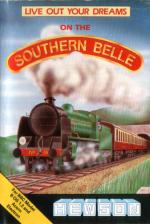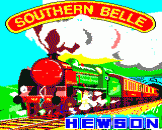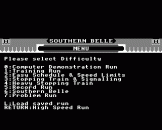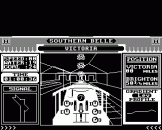Introduction
Journey back to the glorious days of steam about the footplate of the powerful King Arthur class 4-6-0.
Over 100 combinations of journey type, control level and schedule - plus a variety of tricky situations for those tackling the "Problem Run".
Written by Mike Male and Bob Hillyer
Welcome to the Southern Belle - a realistic simulation of a King Arthur class steam locomotive hauling a passenger train from London to Brighton during the early 1930s.
The task before you is to take a steam locomotive and its train from London (Victoria) to Brighton. You must take the roles of both Fireman and Driver. There are many levels of play and we suggest you read thr instructions carefully, then watch the computer demonstration for a few minutes. Study the control settings and then attempt the Training Run. Gradually, you will improve your skill and eventually you will be able to take the Southern Belle to Brighton in accordance with the timetable using the coal and water available to the optimum efficiency.
To load the game type CH."" then RETURN. Note that after one minute on the menu screen the computer will automatically select a high speed run showing the whole route. To return to the menu, press X.
Getting Started
Selecting The Demonstration
Load the program in the usual way. Press key 0 when the main menu appears and then press the RETURN key when the timetable is displayed. the locomotive will pull slowly away from Victoria Station and accelerate past Battersea Power Station. Observe the use of the various controls and study the readings on the gauges. Press CTRL-X to return to the main menu.
The High Speed Run
If RETURN is pressed when the main menu appears the program executes a High Speed Run along the entire line. All the main features along the way including Battersea Power Station, Clapham Junction Station and Clayton Tunnel pass in quick succession. To exit press X.
Starting a Training Run
Press 1 when the main menu appears and 1 again for the locomotive control menu. This will give you control of the Regulator, Cut Off and Brake only. The remainder of the contrls will be worked by the computer. Read the schedule displayed and then press RETURN.
With the locomotive standing at Victoria Station open the Cut Off fully by presing C four times. Half open the Regulator by pressing R twice. After a few moments, the locomotive will pull slowly along the platform and out of the station.
Observe your speed display in the top left corner of the screen. When you are travelling faster than four miles per hour press R twice more to open the regulator fully. The locomotive will then accelerate more rapidly as it climbs the steep incline away from the station on its way over the River Thames and past Battersea Power Station. If you open the regular too soon the locomotive driving wheels will slip on the running rails leading to a loss of traction.
To exit from a Training Run, press CTRL-X.
Screen Layout
In the centre of the screen is the view of the cab, the controls and the line ahead. Above this is a sign naming the next station or feature that you encounter and at the bottom of the screen is the message area. To the left and right of the main display various control information is shown including your speed and the amount of coal and water remaining. The status of the next signal, the gradient profile for the next 1.25 miles and the present time are also shown.
Game Controls
Locomotive Control Keys
| CONTROL | INCREASE SETTING | DECREASE SETTING |
| Sound Whistle | W | |
| Stoke Fire | RETURN | |
| Regular | R | SHIFT-R |
| Vacuum Brake | V | SHIFT-V |
| Cut Off | C | SHIFT-C |
| Blower | B | SHIFT-B |
| Injector | I | SHIFT-I |
| Firedoor | F | SHIFT-F |
| Damper | D | SHIFT-D |
Program Control Keys
| FUNCTION | KEY |
| Toggle between accelerated speed and real-time | A |
| Toggle between smoke on and smoke off | S |
| Return to main menu | CTRL-X |
| Hold, wait for RETURN to restart | H |
| Display timetable | T |
| Acknowledge message | SPACE |
| Increase engine noise | N |
| Decrease engine noice | SHIFT-N |
Smoke Demonstration Keys
| SMOKE LEVEL | KEY |
| Very light smoke - far too much air | 1 |
| Light more -too much air | 2 |
| Correct smoke | 3 |
| Dark smoke - insufficient air | 4 |
Menus, Messages And Speed Limits
Speed Limits
| Limit | Where Limit Applies |
| 40mph | Victoria to Clapham Junction |
| 45mph | Balham Junction (Curve after Balham) |
| 60 mph | Streatham Common for half a mile |
| 45 mph | Windmill Bridge Junction (quarter mile past Selhurst) |
| 50 mph | Far end of Redhill Tunnel to Earlswood |
Error Messages
| Message | Meaning |
| Fusible Plugs Gone | Water level in the boiler too low |
| Boiler Overfill | Water level in the boiler too high |
| Overran Stop Signal | Passing a stop signal in the down position |
| Unsafe Reversing | Allowing the train to run backwards |
| Blowback | Failure to ensure that the blower is on when the regular is shut or when in a tunnel |
| Derailed | Excessive violation of speed limit |
| Crashed Into Brighton Station | Hit buffers at too high a speed |
| Poor Stop At | Failure to stop within 60ft of the end of the platform |
| Short Stop At | Failure to wait for one minute at a station |
| Rough Stop At | Using vacuum brake level three or above when the train comes to a halt at a station |
| No Stop At | Failure to stop at a scheduled stopping station |
| No Whistle At | Failure to sound the whistle before starting off, or before a tunnel or before permanent way working |
| EM Brake At | Using Emergency brake |
| Speeding Near | Failure to observe the speed limit |
The Main Menu In Detail
This run demonstrates the various techniques required to drive the locomotive with the computer running all controls on a non-stop run to Brighton. You are advised to study the various settings used to help you learn correct driving methods.
A practice session for the novice driver/fireman to the same schedule as the computer demonstration. You are expected to observe the drivers notices and adhere to the timetable shown initially. You may halt the run at any time to refer to the timetable again. A short beep is sounded to assis tyou when the computer records a time for the final assessment.
When arriving at Brighton you must bring the train to a halt as near to the far end of the platform as possible. Hitting the buffers will result in the loss of safety marks and doing so at anything above a walking pace will result in a crash. At the end of the run your performance is assessed with recard to economy, safety and timekeeping. A result of 70% overall is considered to be a pass. The economy assessment is based upon the stocks of coal (measured in hundreds of pounds) and water (measured in hundreds of gallon) left in the tender. The timetable is shown, or it can be replaced by a page of significant events.
A train on a non-stop schedule to Brighton. Speed limits, including any additional limit of 30 mph at the Pernanent way working, detailed under the timetable, must be observed otherwise safety marks will be lost and the train may derail.
As option 2 but you must also obey all signals and make the stops required on your timetable.
Signals divide the line into sections so that trains on the same line run at an adequate distanec from each other. There are two types of signal used on this line, stop (with a square end) and distant (with a notched end). Each has two positions, up for clear and down (horizontal) for stop or caution. Stop signals may come singly or in groups.
You must not pass a stop signal in the down (stop) position. To give warning of the condition of the stop signal, a distant signal is placed a suitable distanec before it. It will be down (caution) if the stop signal to which it refers is down i.e. at the stop position.
In order for you to have the maximum time to react the state of the next signal to be passed is repreoduced separately in the signal section on the left of the screen.
The stations at which you are scheduled to stop are shown in capital letters on the timetable. You must attempt to stop within 60ft of the dar end of the platform without excessive braking when coming to a halt. Should you pass the end of the platform before coming to a halt a beep will sound and a "no-stop" error will be recorded against your time.
You must arrive at the station in good time to allow at least one minute for your passengers to embark and disembark. The whistle will sound, if it us under computer control, one minute after your arrival or you may use the second hand on the clock. The times recorder for the assessment are the times at which the train comes to a complte halt and the time it first moves thereafter. The timetable gives the required departure time.
A heavily-laden train with consequent loss of performance. All the constraints of option 3 apply.
On 26th July 1903 the record for a non-stop steam train from London to Brighton was set at 48 minutes 41 seconds. A schedule is supplied to enable you to equal or better that record. All normal speed limits apply.
This is the world famous pride of the Southern Railway Pullman non-stop train. Any deviations from the timetable are viewed with distaste by the railway management and made apparent in the assessment.
You will be presented with any timetable. All constraints apply plus other problems which will hinder your progress to Brighton.
Historical Notes
The London and Brighton Railway Company received permission to construct its lin in 1837. The line was devised by Dir. John John Rennie and joined with the line of the London and Croydon Railway at Norwood. This gave a complete route from London Bridge Station to Brighton. In 1846, the two main route owners merged to form the London, Brighton and South Coast Railway (LB&SCR). The company's desire for its own West London Terminus was satisfied with the opening of Victoria Station in 1860, extending the line from a pervious terminus at Pimlico.
In 1875, the first examples of "Pullman" luxury coaches were introduced by the company, culminating in an all Pullman non-stop London to Bighton tain called the "Southern Belle". It first ran in 1908 and continued until 1972 (running under the name "Brighton Belle" from 1934).
In 1923, the main railway companies of Britain were grouped together into four large ones, the LB&SCR becoming part of the Southern Railway. In 1926, the Souther Railway gave the job of pulling the "Southern Belle" to its powerful and imposing "King Arthur" class locomotives. These continues until the line was electrified in December 1932.
Today the elegancy of the "Southern Belle" has disappeared but the many architectural and engineering features of the line remain.
How a Steam Locomotive Works
These notes describe the operation of a steam locomotive with a particular reference to the screen display and controls of Southern Belle. Understanding how a steam locomotive works will help you to master the controls more quickly.
The driving force of the locomotive comes from the cylinders where a piston is pushed back and forth by the steam pressure raised in the boiler. Hot gasses from the firebox are drawn through the boiler by a system of tubes, which heat the water to boiling point, converting it into steam. The hot gasses drawn through the boiler then enter the smokebox and escape through the chimney. The performance of the locomotive depends upon the pressure in the boiler, which can be controlled by manipulating the fire.
Water Gauges
These are two vertical tubes in the centre of the cab. They are very important as they give a visual indication of the level of water in the boiler. The bottom of the gauge is one inch above the firebox top, which must be kept covered at all times otherwise the fire will heat the firebox top beyond limits causing special plugs (called fusible plugs) to melt allowing steam into the firebox. This action cools the fire and alerts the train crew.
If too much water is carried in the boiler and the gauge reaches the top, water instead of steam will enter the cylinders causing permanent damage.
Ideally you should attempt to maintain a water level in the top half of the gauge. Should a failure occur, the run will be terminated with the consequential loss of marks.
Steam Pressure Gauge
A round dial with a needle pointer, situated in the centre of the cab, graduated from minimum on the left to maximum (200 psi) on the right. The more steam pressure maintained the higher the potential power of the locomotive. However too much pressure will lift the safety valves and release steam thereby reducing pressure to below maximum (shown by two jets of steam issuing from the boiler top). This represents a waste of coal and water and should be avoided to achieve maximum efficiency.
Whistle
The whistle is part of the safety equipment and must always be used before starting away, entering tunnels or approaching sections where permanent way gangs (railway maintenance teams) are working. To conserve steam, the whistle should not be used indiscriminately.
As a guide to correct whistle usage, when the computer is controlling the whistle it is blown at the earliest time in each of the circumstances detailed above.
Regulator
A level situated on the top left of the cab which controls the flow of steam to the cylinders. It has five positions, closed on the right, progressing to fully open on the left. Opening the regulator applies power to the wheels and it must be adjusted when running to suit requirements. Always close the regulator when braking. Open the regulator when starting away as too much power will cause the wheels to slip (especially in adverse weather conditions). Wheel slip will be apparent from the increase in the speed of the steam exhaust.
Cut Off
A wheel control on the bottom left (marked C) which controls the time during the cylinder cycle that steam is allowed into the cylinder. It has five positions, 0% (straight up), 20%, 35%, 55% and 75% (straight down). For example, when the cut off is set to 20%, steam is allowed to enter for just 20% of the cycle. This has the effect that the expansive properties of steam are used more efficiently, by reducing the steam usage significantly for only a small loss of power. You will need to use this control to obtain high efficiency. When starting away, it is normal practice to use 75% cut off.
Vacuum Brake
A wheel control situated between the regulator and the cut off (marked V) which has five positions; off (straight up), light braking, medium braking, heavy braking and emergency braking (straight down). The brakes act upon all the carriages and are held off by maintaining a vacuum in a pipe connecting the carriages, braking being achieved by progressive release of the vacuum via the vacuum brake control.
In the event that the communication cord of the train is pulled, emergency braking is automatically applied and will be released as appropriate. Emergency braking must not be used by the driver except in extreme circumstances, as a poor safety rating will result. Avoid using harsh braking to bring the train to a halt at a station for the comfort of your passengers.
Blower
A wheel control situated centre right of the cab (marked B) which is off when pointing straight up. It is essential that at all times gasflow is maintained drawing the gasses from the firebox out through the chimney ensuring that no flames or gasses are allowed to escape into the cab via the firehole doors. Normally this gasflow is supplied by the exhaust of used steam up the chimney when the regulator is open. This gasflow will be interrupted to closing the regulator or by the confines of a tunnel. In these circumstances, normal gasflow must be maintained by opening the blower which sends a jet of live steam up the chimney. Failure to use the blower when necessary is dangerous and can lead to an "explosive blowback" into the cab. Use of the blower should be limited to only when necessary due to its cost in the loss of steam.
Injectors
A wheel situated top right of the cab (marked I), which controls the device by which water from the tender is forced into the boiler. It has five positions, off (straight up), progressing to full on (straight down). This is the means by which the level of water in the boiler is maintained.
Dampers
A wheel situated on the bottom right of the cab (marked D) which controls the amount of air provided through the base of the fire (called primary air). It has five positions, closed (straight up) progressing to fully open (straight down). By control of the amount of primary air it is possible to vary the temperature of the fire and thereby the amount of water evaporated into steam. To achieve a hot fire a large amount of primary air is required for combustion. Conversely for a cool fire only a small amount of primary air is required. To help you judge the temperature of your fire, a thermometer style temperature gauge is presented in the cab centre. The indication of correct combustion is the colour of your smoke such that black smoke would indicate insufficient air for the temperature of the fire, grey smoke indicates correct air and lighter shades indicate too much air. If too little air is supplied coal combustion will not provide the maximum heat value. If too much air is supplied coal combustion will not provide the maximum heat value. If too much air is supplied, heat will be wasted in heating the excess air. To be efficient you must aim to maintain the correct air supply as far as possible. (Whilst manipulating the fire temperature correct combustion is unlikely). The rate at which coal is consumed increases with the temperature of the fire.
Firehole Doors
A pair of steel doors used to confine the fire and to control the flow of air over the fire (secondary air). To achieve optimum performance of the fire, the level of coal must be maintained in the middle third of the firebox. Coal levels outside these parameters cannot achieve maximum temperatures. You must fully open the firedoors whilst coal is being added (indicated by a shovel at the top right hand corner of the display). Failure to do so will waste coal. In all but the highest level of control the computer will do this for you. For perfect combustion a small amount of secondary air may be required.
The firedoors can also be used to assist in the manipulation of fire temperature. For example to raise the temperature. For example to raise the temperature of the fire "quickly" keep the firedoors shut, and to lower the temperature "quickly" open wide.
Gradients
Railway lines are not level and steam railway locomotives are affected by the gradient of the track. The gradient is indicated in the same manner as road gradients, e.g. 1 in 100. This would indicate a slope up or down of one foot for every 100 feet travelled. A cross section of the gradients of the line together with the positions of the stations and tunnels is shown in the gradient profile included. The exact gradient of the track at any particular time may be displayed in the signalling area.
Vacuum brakes must be used to ensure that the train is never allowed to run backwards on an up gradient.








